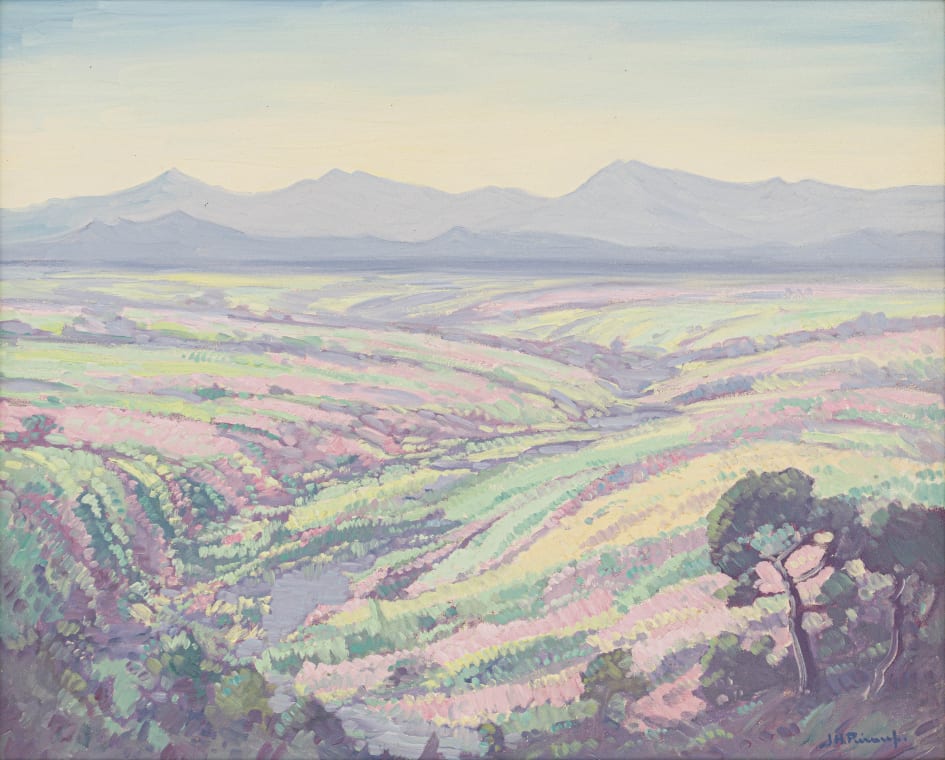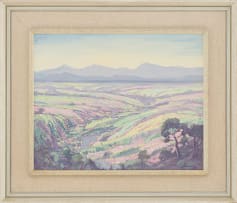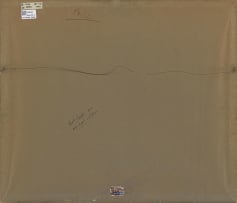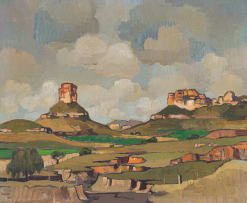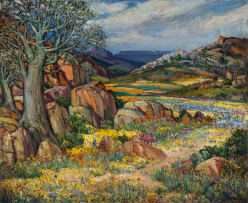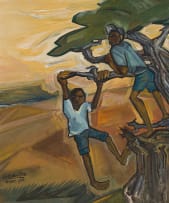Evening Sale
Live Virtual Auction, 17 September 2024
Evening Sale: Modern and Contemporary Art
About this Item
signed; signed, inscribed with the title and 'Posbus 1248; Pretoria' on the reverse; further inscribed with a dedication on the reverse
Notes
Originating in the Soutpansberg Mountains, a northern range frequented by JH Pierneef, the Levubu / Levuvhu River flows in an easterly direction for about 200 km before it joins the Limpopo River in the Kruger National Park. Steeply descending at first, the river flows through a diverse landscape characterised by rapids, riffles, runs and pools. As is shown in this impressionistic work by Pierneef, in its lowveld reaches the river channel is incised into the landscape. It is unclear when Pierneef visited this spot when he produced this colourist scene, but from dates attached to works depicting the Soutpansberg region it is clear that he was an enthusiastic return visitor from at least the 1920s.
Travel, coupled with acute observation in the field, was central to Pierneef's method as an artist. This experiential way of working is linked to his camping excursions north of Pretoria at Pienaar's River, often with sculptor Anton van Wouw, who counselled him to look carefully as an artist. During his subsequent travels, including to the Soutpansberg in 1941, he made many persuasive drawings portraying trees, leaves and thorns, blossoms or curled seed pods, all with "the accuracy of a botanist".1 Equally, when it came to painting the places he visited, Pierneef never abandoned his early love for impressionistic colour.
Esmé Berman, who knew Pierneef, observes that the artist was "not essentially concerned with transient impressions, nor with optical sensations."2 This is true, but also disputed by the glorious choreography of colours - marshalled bands of yellow, pink, green, even blue - that in this composition produce a vivid sensory statement. Despite subordinating colour to formal design in his later works, it was never an ideology. A muted palette was also never a must.
"One of Pierneef's inheritances from Impressionist landscape was a 'blonde' colour range," writes art historian Anna Tietze. "The Impressionists famously moved away from the reliance on blacks, browns and dark greens that had characterised much earlier landscape art and substituted these with lighter colour effects. Blues, greens, pinks, violets became the foundation of a sunnier vision and shadows were indicated with a darkening of the dominant hues rather than by recourse to earth colours."3 Of course, in the foreground of this composition Pierneef uses brown, but it is his overall use of vivid colour that intensifies the dramatic effect of this recessive rural landscape.
1.JFW Grosskopf (1947) Pierneef: The Man and his Work, Pretoria, Van Schaik, page 13
2. Esmé Berman1993) Painting in South Africa, Halfway House, Southern Book Publishers, page 46
3. Anna Tietze (2022) "Masterpiece of the Month: Jacob Hendrik Pierneef, N'tabeni (1930)" Iziko South African National Gallery: https://www.iziko.org.za/masterpiece/masterpiece-of-the-month-jacob-hendrik-, accessed 20 August 2024.
View all Jacob Hendrik Pierneef lots for sale in this auction
